Speech An Economic Update
I would like to thank the Armidale Business Chamber for the invitation to speak this evening. I grew up in regional New South Wales – in Cootamundra and Wagga Wagga – so it is a treat for me to have been invited to speak in another great regional city. Thank you.
Tonight, I would like to provide you with an economic update. I will focus first on the global situation and then talk about the Australian economy. And finally, I will make some remarks about monetary policy.
The main message on the global economy is that while it is still growing reasonably well, the risks are increasingly tilted to the downside. The main source of these downside risks are geopolitical developments in many parts of the world. These developments are creating considerable uncertainty and this uncertainty is causing businesses to reconsider their spending plans. This is making the international environment more challenging for us.
On the Australian economy, there are two main messages.
The first is that after having been through a soft patch, a gentle turning point has been reached. While we are not expecting a return to strong economic growth in the near term, we are expecting growth to pick up. Against this backdrop, the main source of domestic uncertainty continues to be the strength of household spending.
The second message is a longer-term one. And that is the fundamental factors underpinning the longer-term outlook for the Australian economy remain strong. One of the ongoing challenges we face as a country is to capitalise on those strong fundamentals.
The Global Economy
This first graph shows global economic growth and the International Monetary Fund's (IMF) forecasts for the next few years (Graph 1). Looking at this graph, one might ask why the concern: global growth has been stable and reasonable over recent times and the IMF is forecasting this to continue over the next couple of years. If this forecast were to come to pass, that would make for 12 years of solid growth.
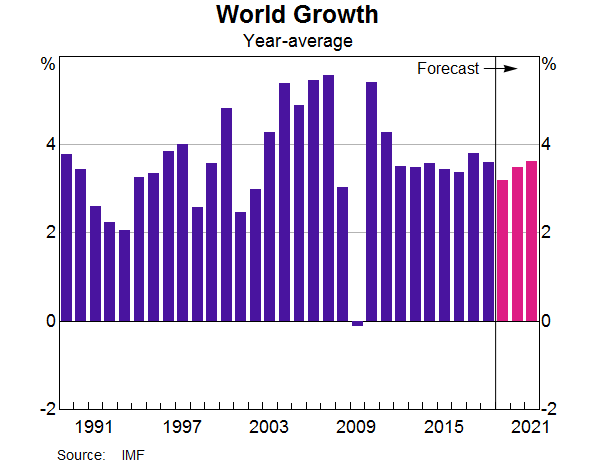
Looking at labour markets, one might also ask why the concern. Unemployment rates in most advanced economies are the lowest they have been in many decades, and businesses are finding it more difficult to fill jobs (Graph 2). These tighter labour markets are finally translating into stronger wages growth, with wages now increasing at close to the rates seen before the financial crisis in some countries. With inflation remaining low, this pick-up in wage growth is translating into real wage increases and strong growth in household spending.
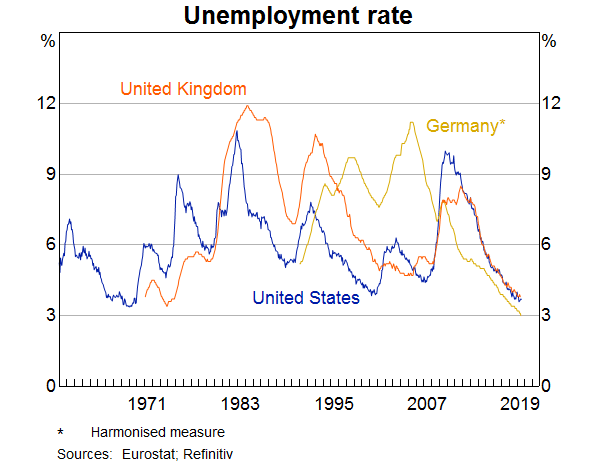
So why the concern?
The answer is the increased downside risks generated by various geopolitical developments. The most prominent of these are the trade and technology disputes between the United States and China. Others include: the Brexit issue, developments in the Middle East, the problems in Hong Kong and the tensions between Japan and South Korea.
The US–China disputes, in particular, are having a disruptive effect on international trade flows. Over the past year there has been no growth at all in international trade, despite the global economy growing at a reasonable rate (Graph 3). This weakness on the trade front is flowing through to factory output, with growth in industrial production slowing considerably.
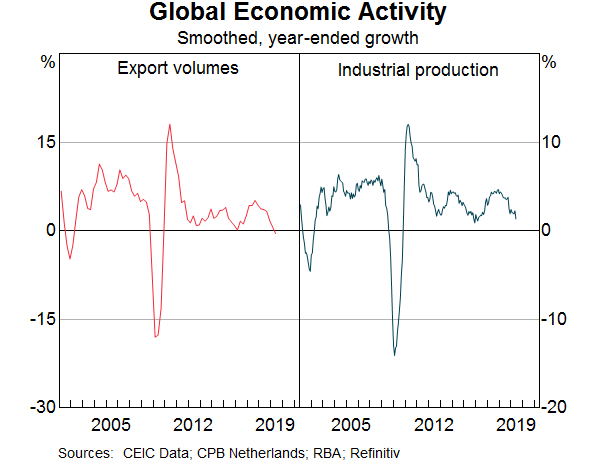
More broadly, though, the geopolitical concerns are creating considerable uncertainty about the future. This can be seen in measures of economic policy uncertainty constructed from news stories in leading media around the world (Graph 4).
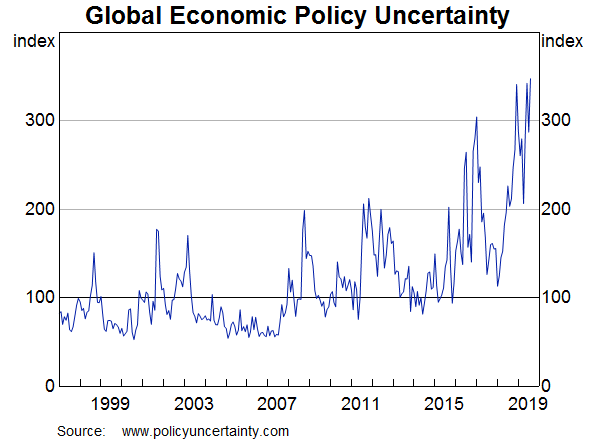
In the face of this uncertainty, it is not surprising that many businesses are preferring to wait before committing to significant investments; they are inclined to sit on their hands for a while and see how things play out. This is evident in the surveys of business investment intentions, which have fallen considerably (Graph 5). The effect is also evident in June quarter GDP figures, with GDP declining in Germany, the United Kingdom and Singapore.
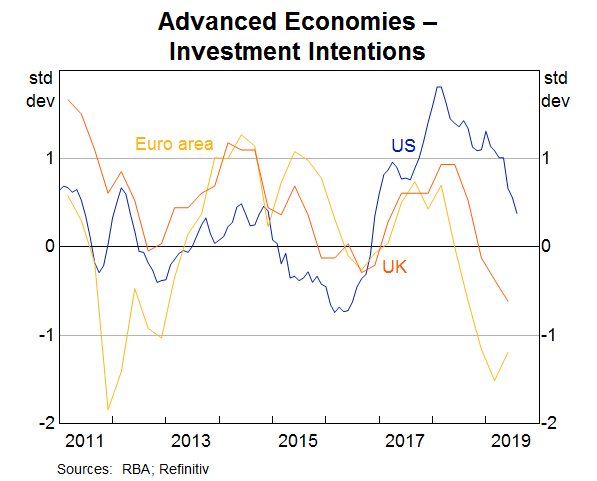
A particular concern is that if this uncertainty continues, businesses might decide not only to defer investment, but to also defer hiring. Of course, it is also possible that some of these uncertainties will be resolved. If this were to happen, the global economy could grow quite strongly as firms caught up on their capital spending in an environment of easy financial conditions.
Notwithstanding this possibility, as the downside risks have come more clearly into focus, there has been a marked shift in the outlook for monetary policy globally. Almost all major central banks are expected to ease monetary policy over the year ahead, with the United States Federal Reserve and the European Central Bank having already moved in this direction (Graph 6). Given that inflation is low – and forecast to remain low – investors are also expecting central banks to maintain very accommodative settings of monetary policy for years to come.
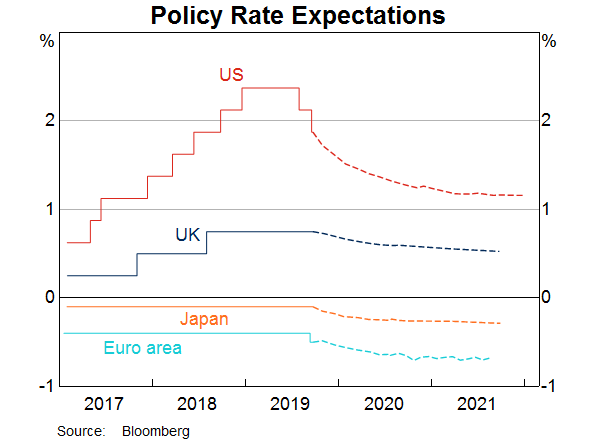
This expectation has had a major effect on long-term bond yields around the world. In Europe and Japan, investors are paying governments to hold their money for them (Graph 7). The Swiss Government, for example, can borrow for 30 years at a negative interest rate of 0.5 per cent. For the world as a whole, around a quarter of the total stock of government bonds on issue has negative yields. And where yields are in positive territory, they are at very low levels and in many cases at the lowest on record.
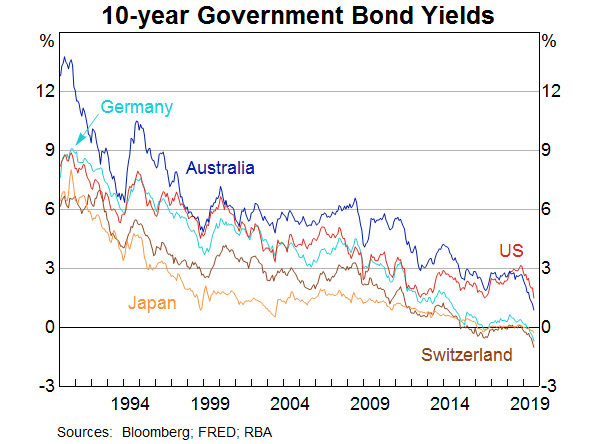
All this is making for a challenging international environment.
The Australian Economy
I would now like to move to the Australian economy.
Over recent times, our economy has been going through a soft patch. Over the year to June, GDP grew by just 1.4 per cent, which is the slowest year-ended growth for some years (Graph 8). We did not expect this slowdown, so it has come as a bit of a surprise.
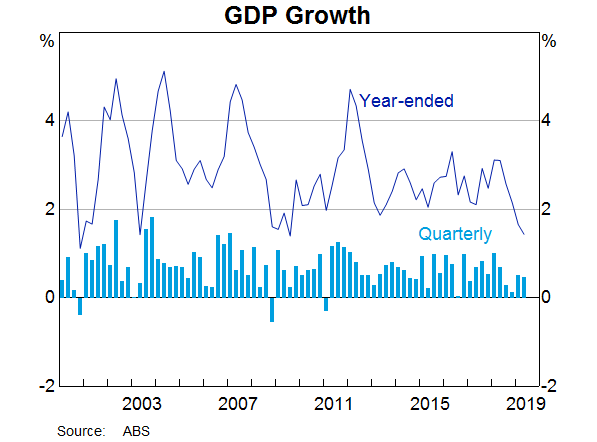
It is important, though, that we keep things in perspective. The economic expansion in Australia has now been running for 28 years. That is quite an achievement. Over such a long expansion, there are going to be ebbs and flows in growth. There are also going to be periods where growth is stronger than expected – as it was in the first half of 2018 – and other periods, like now, where growth is weaker than expected.
With the benefit of hindsight, there are a few factors that help explain the slowing in the Australian economy over the past year.
One is the international developments that I spoke about earlier. While Australia has been less directly affected by the US–China trade disputes than have many other countries, there is an indirect effect through slower global growth and increased global uncertainty.
A second and more important factor is weak consumption growth.
Over the past year, there has been no growth at all in consumption per person, which is an unusual outcome at a time when employment is growing strongly (Graph 9). An important part of the explanation here is that household disposable income has been increasing only slowly for an extended period, reflecting both subdued wage increases and strong growth in taxes paid.
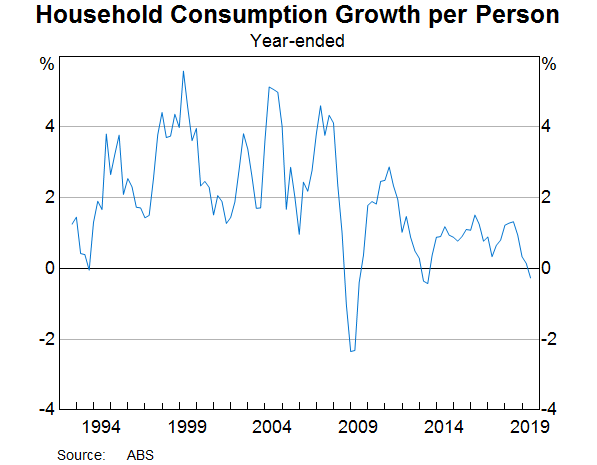
The persistence of slow growth in household income has led many people to reassess how fast their incomes will increase in the future. As they have done this, they have also reassessed their spending, particularly on discretionary items, which has been quite weak over recent times (Graph 10). Not surprisingly, spending on household essentials has been much less affected.
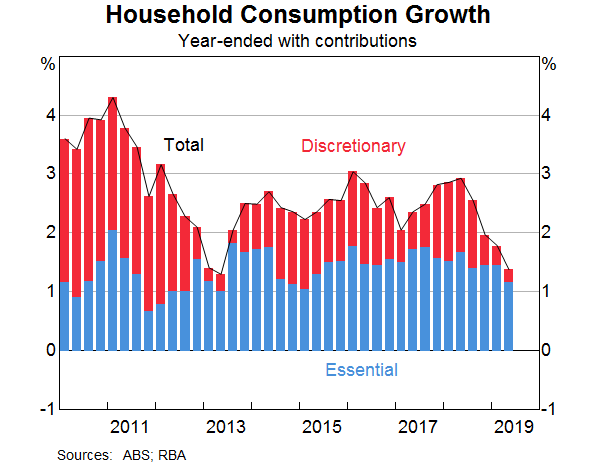
Another part of the explanation for weak growth in household spending is the adjustment in the housing market. As housing prices have fallen, there has been a marked decline in housing turnover, with the turnover rate having declined to the lowest level in more than 20 years (Graph 11). With fewer of us moving homes, spending on new furniture and household appliances has been quite soft. So too has expenditure on moving costs and real estate fees. More broadly, the correction in the housing market has also affected the economy through its impact on residential construction activity.
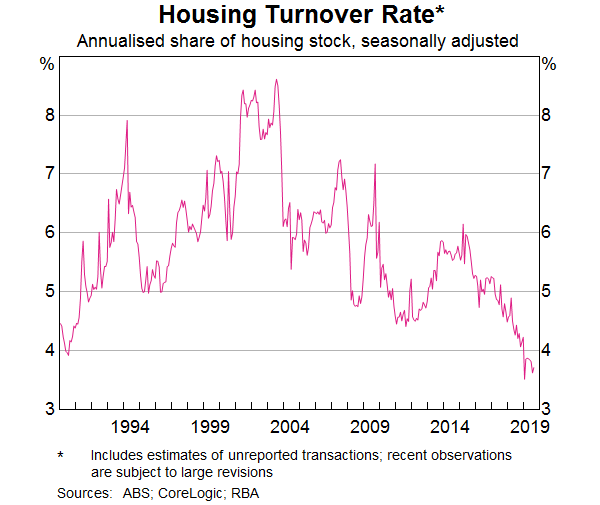
A third factor contributing to the slower growth has been the drought.
Across the Murray-Darling Basin, including here in the Northern Tablelands, farmers have faced extremely dry conditions. Indeed, as indicated in this graph, in some areas conditions have been the driest on record (Graph 12). Reflecting this, farm output in Australia has fallen for the past two years and there has been a sharp drop in farm income as farmers have had to cope with the increased costs for obtaining feed and water. These difficult conditions have contributed to the weakness in overall household incomes and consumption, and the effects are particularly felt in regional communities. The drought has also put upward pressure on food prices over the past year, particularly for bread, milk and meat. We are all hoping that the drought breaks soon.
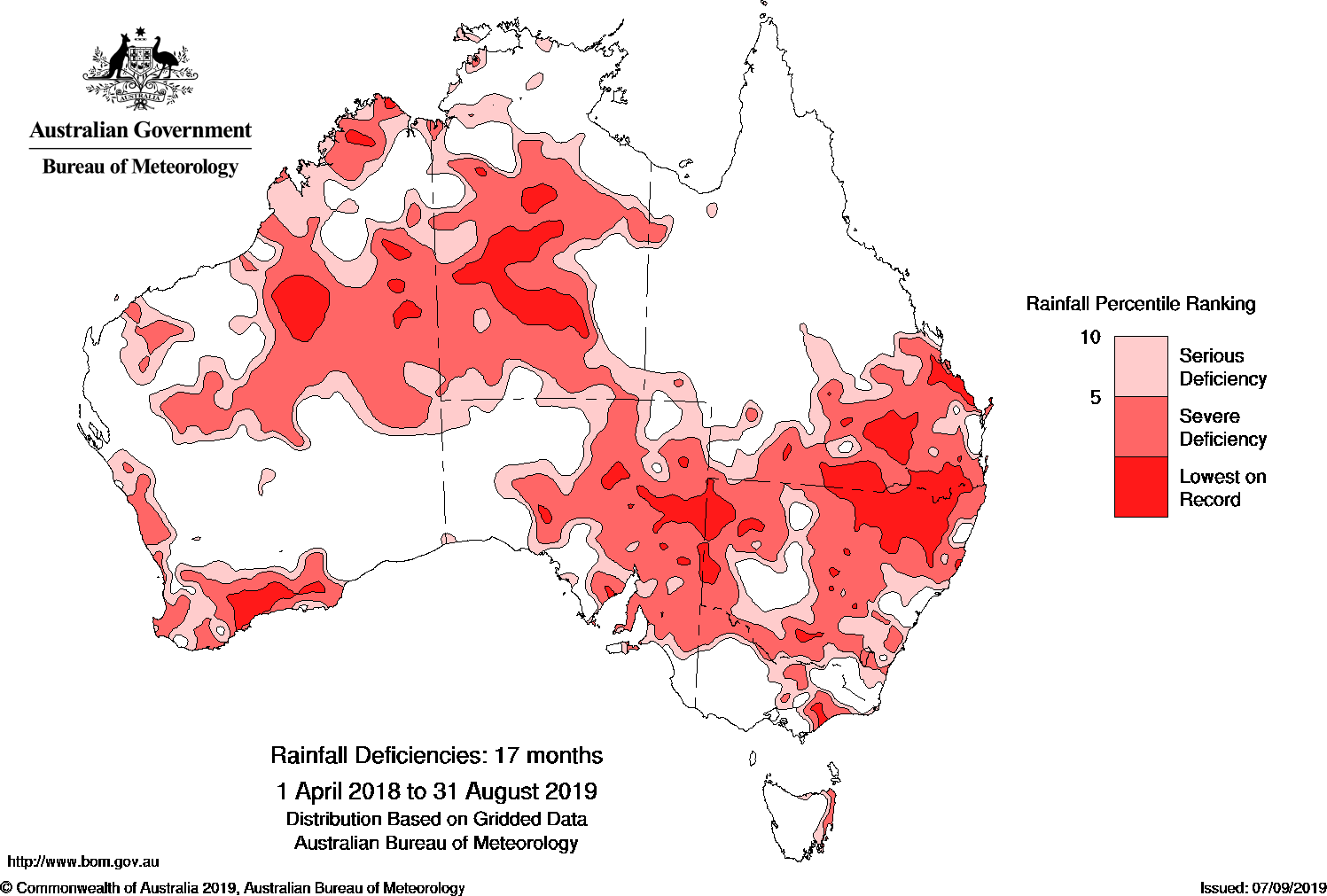
© Commonwealth of Australia 2019, Australian Bureau of Meteorology; available at <http://www.bom.gov.au/climate/drought/> under Creative Commons Attribution 3.0 Australia Licence. Full terms at <http://creativecommons.org/licenses/by/3.0/au/>.
Even after accounting for these three factors – the slowdown overseas, weak growth in household disposable incomes and the drought – part of the slowing in the Australian economy remains unexplained. This is especially so taking into account the labour market data, which continue to paint a stronger picture of the economy than the GDP data.
Over recent times, employment growth has been stronger than was expected. Over the past year, the number of people with a job increased by 2½ per cent (Graph 13). Reconciling this with GDP growth of just 1½ per cent remains a challenge, because, normally, output growth exceeds employment growth, rather than falls short. We are seeking to understand what is going on here. It is possible that it is just measurement noise, but we can't yet rule out something more structural.
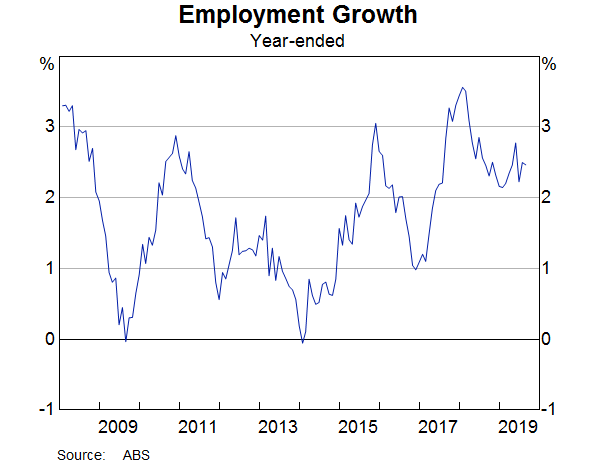
The other striking feature of the labour market over recent times has been a large increase in labour supply. In particular, there has been a material lift in the labour force participation by women and by older Australians (Graph 14). As a result, the increase in labour supply has more than outstripped the increase in labour demand. Reflecting this and despite the strong employment growth, the unemployment rate has moved higher since the start of the year to 5¼ per cent.
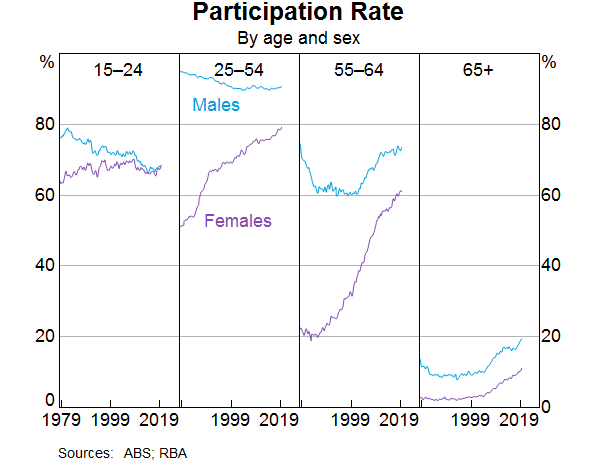
This increase in labour supply is a positive development, but it does mean that it is proving quite difficult to generate a tight labour market with the flow-on consequence that wage increases remain subdued. Over the past year, the Wage Price Index increased by just 2.3 per cent (Graph 15). This is a pick-up from the rates of recent years, but the lift in wages growth looks to have stalled recently. Another relevant factor here is the ongoing caps on wage increases in the public sector.
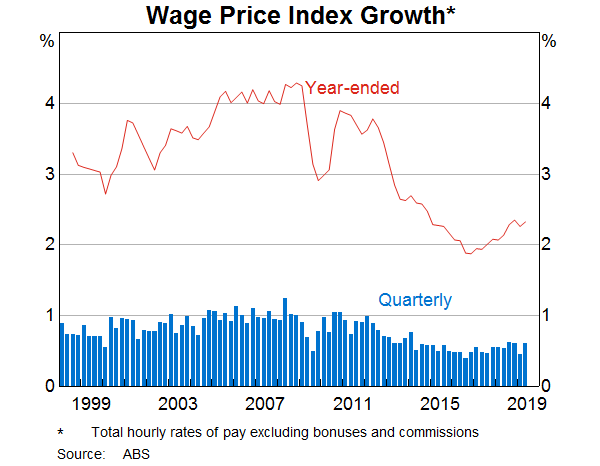
Low wages growth is one of the factors contributing to low inflation outcomes. Over the year to June, inflation was 1.6 per cent, in both headline and underlying terms (Graph 16). Another contributing factor is the adjustment in the housing market, with rents increasing at the slowest rate in decades and declines being recorded in the price of building a new home in some cities (Graph 17). Another factor is various government initiatives to address cost-of-living pressures, with these initiatives pushing down inflation in administered prices. The price rises for utilities are also much lower than over recent years. Working in the other direction, the drought and the depreciation of the exchange rate have been pushing up retail prices over the past year.
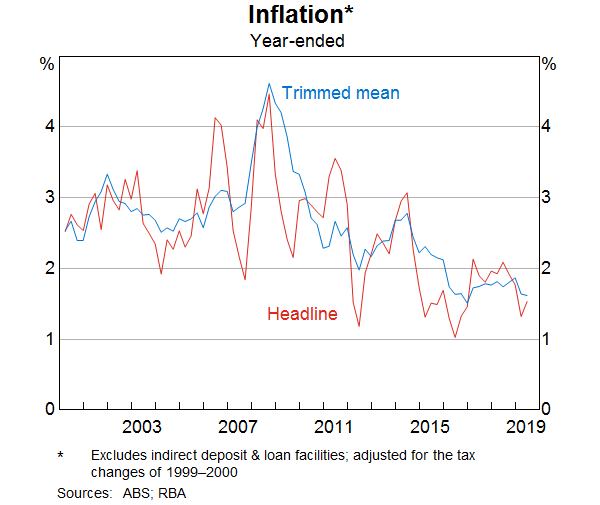
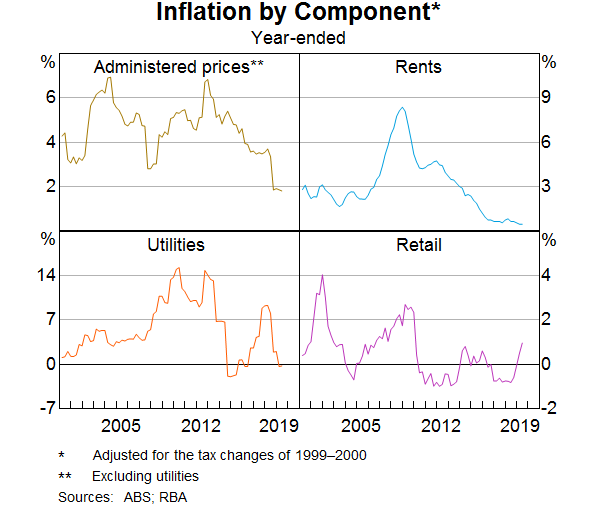
Looking forward, there are some signs that, after a soft patch, the economy has reached a gentle turning point. This is evident in the fact that GDP growth over the first half of this year was stronger than it was over the second half of last year (Graph 8). We are expecting a further modest pick-up in the quarters ahead.
This outlook is supported by a number of developments, including lower interest rates, the recent tax cuts, the depreciation of the Australian dollar, ongoing spending on infrastructure, the stabilisation of the housing markets in some cities and a brighter outlook for the resources sector. It is reasonable to expect that, together, these factors will see growth in the Australian economy return to around its trend rate next year, although there are some obvious risks to this outlook.
One factor that should help is an expected pick-up in household disposable income. Many households are currently receiving larger tax refunds due to the low and middle income tax offset. These payments will boost aggregate household income by 0.6 per cent this year. Past experience suggests that around half of these tax refunds will be spent over coming quarters. Household disposable income is also being boosted by lower interest rates, although the effect is uneven across the community, with lower rates reducing the income of those households who rely on interest income. Household spending should also be supported by an increase in housing turnover. Working in the other direction, though, is a further contraction in residential construction activity.
Another positive element is likely to come from the resources sector. Mining investment is expected to increase over the next year, after having declined for six years as the LNG investment boom wound down (Graph 18). Mining companies are increasing their investment not only to sustain their current production levels but, in some cases, to expand capacity as well. There has also been a pick-up in exploration activity. To be clear, we are not predicting a return to boom-time conditions in the resources sector. But we are predicting better times for the sector ahead.
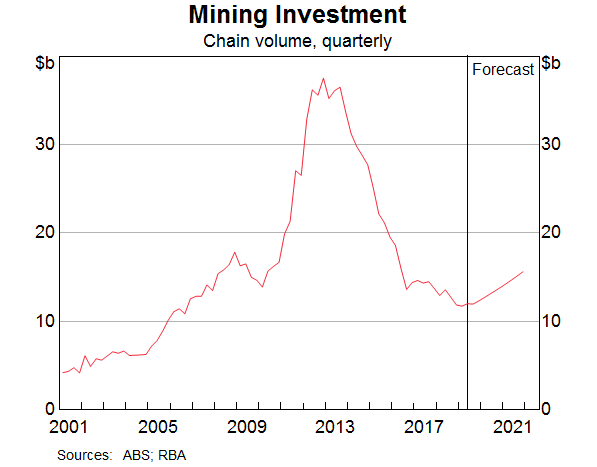
Business investment elsewhere in the economy is also expected to move higher. Earlier I discussed how uncertainty globally is affecting the outlook for investment in many countries. Fortunately, we don't see the same spike in the measure of policy uncertainty in Australia that I showed in the earlier graph for the world economy. There has, however, been some softening in measures of business conditions – from well above average to around average.
The investment outlook is being supported by a solid pipeline of infrastructure projects. This ongoing investment in infrastructure is not only supporting demand in the economy at a time when this is needed, but it is also adding to the supply capacity of the economy and directly improving people's lives, including through providing better services and reducing transport congestion.
Together, it is reasonable to expect that these various factors will see annual growth pick up from here. Apart from the international uncertainties, the main source of uncertainty around this outlook continues to be the strength of household spending. It remains the case that a sustained pick-up in household spending will require faster growth in household incomes than we have seen over recent times.
As we grapple with these issues, it is important that we do not lose sight of the fact that the Australian economy has strong fundamentals.
Australia is fortunate in having enviable endowments of natural resources, both in terms of minerals and agricultural land. We have a reputation as a highly reliable supplier and a producer of high-quality clean food. We also have close links with the rapidly growing countries of Asia. Three of the four most populous countries in the world – China, India and Indonesia – are in our neighbourhood. And our ties with these countries are strengthened by the many people from there who live, work and study in Australia.
Our demographics are also reasonably favourable. Our population is aging less quickly than that of many other advanced economies. The population is also growing relatively rapidly for an advanced economy – 1.7 per cent a year, compared with 0.6 per cent in the United States and declining populations in some countries in north Asia and Europe. Immigration has been a strong contributor to this: almost half of us were born overseas or have at least one parent who was born overseas. While we have struggled to meet the infrastructure needs that come with this growing population, it does bring a dynamism that is not easily matched in countries with declining populations.
We also have a highly talented, flexible and adaptive workforce. We have strong public institutions, a well-established macroeconomic framework, and the rule of law is respected. There is also a demonstrated record of responsible fiscal policy and low public debt. And, finally we benefit from having both a flexible exchange rate and a flexible labour market. So, our fundamentals are strong.
The challenge we face is to fully capitalise on these fundamentals. If we can do this then I am confident that we can, once again, experience strong growth in real incomes in Australia.
Monetary Policy
I would like to finish with some remarks about monetary policy.
As you would be aware, the Reserve Bank Board lowered the cash rate in June and July to a new low of 1 per cent. Financial markets are pricing in further reductions in the cash rate over the next year.
Our decisions – and the expectations of investors about the future – reflect both international and domestic factors.
On the international front, as I discussed earlier, interest rates around the world are low and they are moving lower. There are many reasons for this, but the central reason is that the global appetite to save is elevated relative to the global appetite to use those savings to invest in new productive capital. When lots of people want to save and there is not much demand for those savings, savers earn low returns.
We live in an interconnected world, which means that we cannot completely insulate ourselves from long-lasting shifts in global interest rates. Our floating exchange rate gives us a degree of monetary independence, but we can't ignore structural shifts in global interest rates. If we did seek to ignore these shifts, our exchange rate would appreciate, which, in the current environment, would be unhelpful in terms of achieving both the inflation target and full employment.
As I have spoken about on other occasions, the key to more normal interest rates globally is addressing the factors that are leading to a depressed appetite to invest relative to the appetite to save. Whether or not this will happen, time will tell. But as a small open economy, we have to take the world and global interest rates as we find them.
On the domestic front, there has been an accumulation of evidence over recent times that the economy can sustain lower rates of unemployment and underemployment than previously thought likely. The flexibility of labour supply also means that strong rates of employment growth can be sustained without inflation becoming a problem. These are both positive developments.
Inflation has been below the 2–3 per cent medium-term target range for some time now for the reasons that I spoke about earlier. Looking ahead, inflation is expected to pick up, but to remain below the midpoint of the target range for some time to come.
The decisions to ease monetary policy in June and July were taken to help make more assured progress towards full employment and the inflation target. Further monetary easing may well be required. While we are at a gentle turning point and expect growth to pick up, the strength and durability of this pick-up remains to be seen.
Regardless of the short-term outlook for monetary policy, the point about the solution to low global rates is relevant here in Australia too. We will all be better off if businesses have the confidence to expand, invest, innovate and hire people. Given Australia's strong fundamentals, this is not out of our reach, but it does require constant effort.
At our Board meeting next week, we will again take stock of the evidence. It is nevertheless likely that an extended period of low interest rates will be required in Australia to make progress in reducing unemployment and achieving more assured progress towards the inflation target. The Board is prepared to ease monetary policy further if needed to support sustainable growth in the economy, make further progress towards full employment, and achieve the inflation target over time.
Thank you for listening. I look forward to answering your questions.
Endnotes
I would like to thank Ellis Connolly for assistance in the preparation of this talk. [*]
